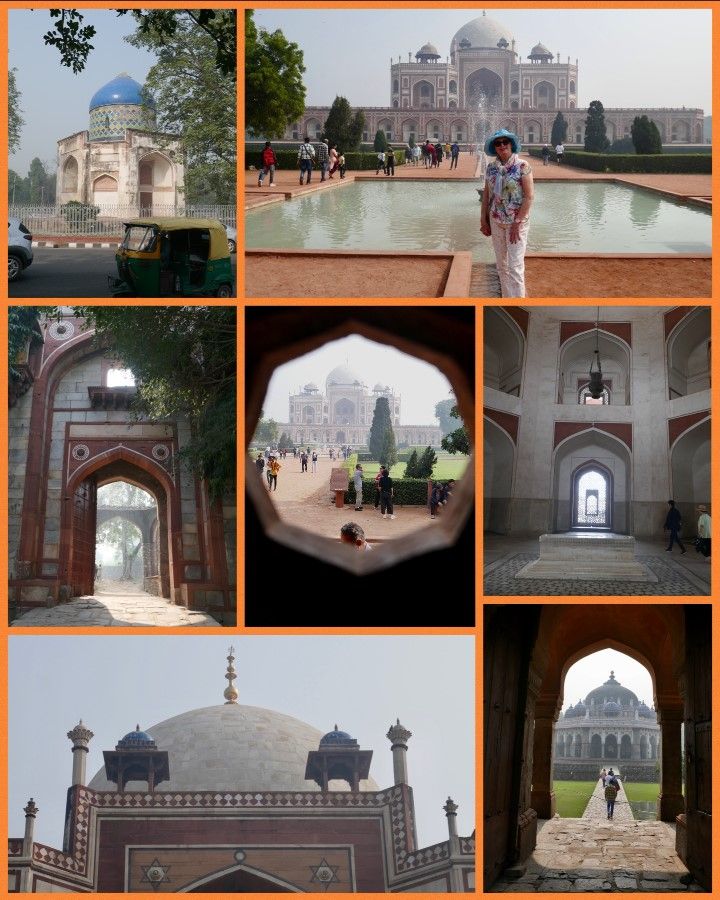Incredible India - Delhi

I’m travelling again, this time with a girlfriend on a tour to Incredible India - with over a billion people, it’s the most populated country in the world with the largest democracy. It has the 3rd largest military and ranks as the 7th largest country (Australia is 6th). In 2 weeks we can only cover a small part - the Golden Triangle of Delhi, Agra and Jaipur (the capital of Rajasthan State - known as the Land of Kings), as well as a day or so in Mumbai.

The capital Delhi with a population of over 30 million is incredible too - more than the entire population of Australia!
The city is a cacophony of colourful chaos - cars, rickshaws, tuk-tuks, buses and carts - drawn by horses or people. They all vie for position at traffic lights, spilling through the streets and laneways, people living in cramped quarters in every available space or further out in tall apartment buildings that stretch as far as the eye can see.
Yet it’s a green city with spacious parklands and many streets are lined with trees. Despite terrible pollution, congested roads and limited space, smiles breakout at every opportunity. Children and adults alike curious to know where we are from - often asking for photos with their families, the kids thrilled when they can pose for a candid shot.
We merged into the crowd as our rickshaws swerved between honking buses and traders hawking their wares though Chandni Chowk, the main market in Old Delhi. I loved it all, taking in the myriad of sounds and sights.

The history of Delhi can be traced back to the 6th Century BCE, captured, ransacked and rebuilt many times, serving as a capital of various kingdoms and empires.
Portuguese, then the British have left their mark in more recent centuries, all wanting a slice of the lucrative spice market - the British ruling from 1858. Their architect Edwin Lutyens, designed the city of New Delhi in 1920s and 1930s. Their legacy remains - boulevards lined with colonial government buildings many radiating from India Gate, a ceremonial arch and war memorial to commemorate the 90,000 Indian army soldiers who died in WWI, the North-West Frontier and 1919 Anglo-Afghan War.

India gained independence in 1947 when Mahatma Gandhi successfully galvanised peasants and villagers in a passive resistance that spearheaded the national movement. Hindu-Muslim differences caused turmoil and riots with untold deaths. The Partition of Pakistan was formed to satisfy the Muslim intent to distance themselves from a Hindu dominated country.
The turmoil did not end there - Gandhi was assassinated soon by a Hindu extremist who did not support his inclusive policies. Known as the Father of India Gandhi inspired civil rights leaders around the world for his philosophy of nonviolence.
Going back to the 15th and 16th centuries, Islamic Moghul dynasties ruled - Babur, Humayun, Akbar, Jehangir, Shan Jahan and Aurangzeb, responsible for the architecture of many monuments and buildings in Old Delhi and Agra.
Shan Jahan founded the Red Fort, the centre of his new capital, which we passed several times, surrounded by 18m walls - it’s said, for good luck, decapitated bodies of prisoners were buried in the foundations!
He also built Juma Masjid Mosque, the largest in India with a capacity of 25,000 - we visited on a non-prayer day - a quiet haven towering over the mayhem of the market. This post's opening image shows the Mosque on a busy prayer day - easy to see how the mosque can accommodate 25,000. Shah Jahan commissioned the building of the Taj Mahal too! 1

Next the tomb of Shah Jahan's predecessor Humayun, floating in an ethereal haze, above symmetrical gardens - thought to have inspired the Taj Mahal, built 60 years later.
Constructed on the orders of Humayun’s Persian wife, it combines both Moghul and Persian architecture, following Islamic geometry, in white marble and red sandstone.

We only had one and a half days in Delhi, not much time to see the many riches and absorb the centuries of history and culture it has to offer.
Stepping further back in time, we visited Qutb Minar - it’s iconic Afghan style minaret at 73m, was erected by Sultan Qutb-ud-din Aibak in 1193 in victory over Hindu rulers, with verses from the Quran intricately carved along the sandstone bands.
At its foot, stands the remains of India’s first mosque which was used until 1360. An inscription indicates it was built with materials from 27 demolished ‘idolatrous temples’; the carvings a fusion of Islamic and pre-Islamic, Hindu and Jain styles.

Even more ancient is the 6.7m high iron pillar in the courtyard. It hasn’t rusted in over 1600 years and today’s scientists are at a loss to know how the iron was cast using the technology of that time. A six-line Sanskrit inscription suggests it was originally erected outside a Vishnu temple in memory of Chandravupta II, who ruled from 375CE to 413CE.
One of the joys of travelling in India is the people - welcoming smiles at every turn. Families always requesting photos with us. The children happy and keen to be part of the fun.

Enjoy the 10 min video below, by blogggers Rhett and Claire during their time around Delhi in 2022 which conveys not just the noise and chaos of this vibrant city, but also Delhi's charm and delight of the people. There are a few advertisements, but you may be able to skip through those.
Join me tomorrow as we visit Agra and the Taj Mahal - said to be the most beautiful building in the world.
